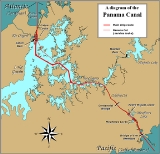
in Panama
that joins the Atlantic Ocean
and the Pacific Ocean
and is a key conduit for international maritime trade. Built from 1904 to 1914, the canal has seen annual traffic rise from about 1,000 ship
s early on to 14,702 vessels measuring a total of 309.6 million Panama Canal/Universal Measurement System (PC/UMS) tons in 2008. In total, over 815,000 vessels have passed through the canal.
1880 Ferdinand de Lesseps begins French construction of the Panama Canal.
1900 The United States and the United Kingdom sign a treaty for the Panama Canal
1902 The U.S. Congress passes the Spooner Act, authorizing President Theodore Roosevelt to acquire rights from Colombia for the Panama Canal.
1902 The United States buys the rights to the Panama Canal from France.
1903 The Hay-Herran Treaty, granting the United States the right to build the Panama Canal, is ratified by the United States Senate. The Colombian Senate would later reject the treaty.
1904 Construction begins by the United States on the Panama Canal.
1906 Theodore Roosevelt is the first sitting President of the United States to make an official trip outside the country. He did so to inspect progress on the Panama Canal.
1909 Workers start pouring concrete for the Panama Canal.
1913 President Woodrow Wilson triggers the explosion of the Gamboa Dike thus ending construction on the Panama Canal.
1914 The Panama Canal opens to traffic with the transit of the cargo ship Ancon.

